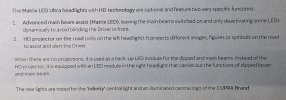I currently have a Tiguan which has Matrix lights and looking at the Terramar VZ2 it has Matrix LED Ultra lights. What's the actual difference between the two? I've seen in an online video that there are some kind of emphasis on the lane which I can imagine being really distracting or is it not as bad as it appears?

With the time of year it's a bit difficult to test it on a test drive, but is it something that can be turned off?
With the time of year it's a bit difficult to test it on a test drive, but is it something that can be turned off?




